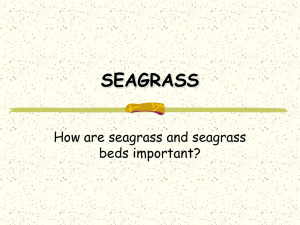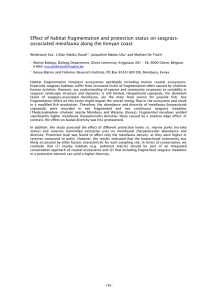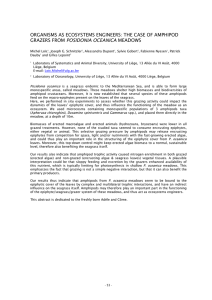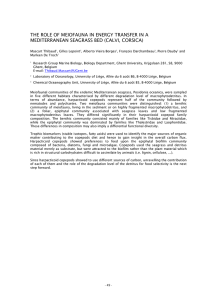Long Term Land Cover and Seagrass Mapping Using Landsat Sensors... the Coastal Environment of South East Queensland, Australia
advertisement
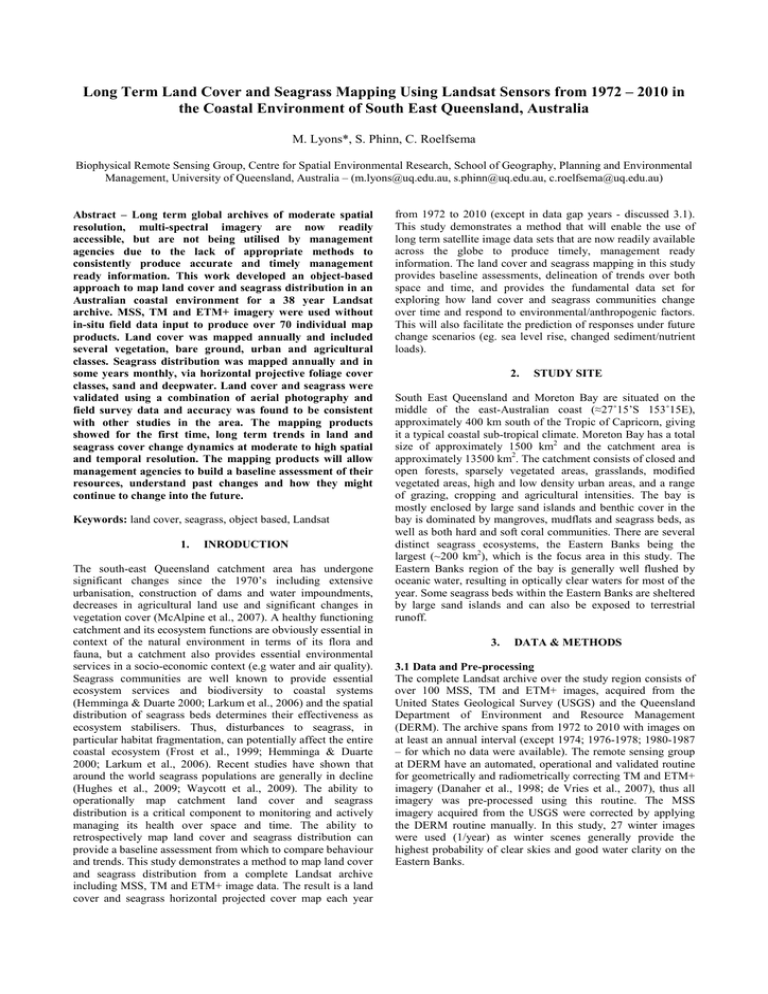
Long Term Land Cover and Seagrass Mapping Using Landsat Sensors from 1972 – 2010 in the Coastal Environment of South East Queensland, Australia M. Lyons*, S. Phinn, C. Roelfsema Biophysical Remote Sensing Group, Centre for Spatial Environmental Research, School of Geography, Planning and Environmental Management, University of Queensland, Australia – (m.lyons@uq.edu.au, s.phinn@uq.edu.au, c.roelfsema@uq.edu.au) Abstract – Long term global archives of moderate spatial resolution, multi-spectral imagery are now readily accessible, but are not being utilised by management agencies due to the lack of appropriate methods to consistently produce accurate and timely management ready information. This work developed an object-based approach to map land cover and seagrass distribution in an Australian coastal environment for a 38 year Landsat archive. MSS, TM and ETM+ imagery were used without in-situ field data input to produce over 70 individual map products. Land cover was mapped annually and included several vegetation, bare ground, urban and agricultural classes. Seagrass distribution was mapped annually and in some years monthly, via horizontal projective foliage cover classes, sand and deepwater. Land cover and seagrass were validated using a combination of aerial photography and field survey data and accuracy was found to be consistent with other studies in the area. The mapping products showed for the first time, long term trends in land and seagrass cover change dynamics at moderate to high spatial and temporal resolution. The mapping products will allow management agencies to build a baseline assessment of their resources, understand past changes and how they might continue to change into the future. Keywords: land cover, seagrass, object based, Landsat 1. INRODUCTION The south-east Queensland catchment area has undergone significant changes since the 1970’s including extensive urbanisation, construction of dams and water impoundments, decreases in agricultural land use and significant changes in vegetation cover (McAlpine et al., 2007). A healthy functioning catchment and its ecosystem functions are obviously essential in context of the natural environment in terms of its flora and fauna, but a catchment also provides essential environmental services in a socio-economic context (e.g water and air quality). Seagrass communities are well known to provide essential ecosystem services and biodiversity to coastal systems (Hemminga & Duarte 2000; Larkum et al., 2006) and the spatial distribution of seagrass beds determines their effectiveness as ecosystem stabilisers. Thus, disturbances to seagrass, in particular habitat fragmentation, can potentially affect the entire coastal ecosystem (Frost et al., 1999; Hemminga & Duarte 2000; Larkum et al., 2006). Recent studies have shown that around the world seagrass populations are generally in decline (Hughes et al., 2009; Waycott et al., 2009). The ability to operationally map catchment land cover and seagrass distribution is a critical component to monitoring and actively managing its health over space and time. The ability to retrospectively map land cover and seagrass distribution can provide a baseline assessment from which to compare behaviour and trends. This study demonstrates a method to map land cover and seagrass distribution from a complete Landsat archive including MSS, TM and ETM+ image data. The result is a land cover and seagrass horizontal projected cover map each year from 1972 to 2010 (except in data gap years - discussed 3.1). This study demonstrates a method that will enable the use of long term satellite image data sets that are now readily available across the globe to produce timely, management ready information. The land cover and seagrass mapping in this study provides baseline assessments, delineation of trends over both space and time, and provides the fundamental data set for exploring how land cover and seagrass communities change over time and respond to environmental/anthropogenic factors. This will also facilitate the prediction of responses under future change scenarios (eg. sea level rise, changed sediment/nutrient loads). 2. STUDY SITE South East Queensland and Moreton Bay are situated on the middle of the east-Australian coast (≈27˚15’S 153˚15E), approximately 400 km south of the Tropic of Capricorn, giving it a typical coastal sub-tropical climate. Moreton Bay has a total size of approximately 1500 km2 and the catchment area is approximately 13500 km2. The catchment consists of closed and open forests, sparsely vegetated areas, grasslands, modified vegetated areas, high and low density urban areas, and a range of grazing, cropping and agricultural intensities. The bay is mostly enclosed by large sand islands and benthic cover in the bay is dominated by mangroves, mudflats and seagrass beds, as well as both hard and soft coral communities. There are several distinct seagrass ecosystems, the Eastern Banks being the largest (~200 km2), which is the focus area in this study. The Eastern Banks region of the bay is generally well flushed by oceanic water, resulting in optically clear waters for most of the year. Some seagrass beds within the Eastern Banks are sheltered by large sand islands and can also be exposed to terrestrial runoff. 3. DATA & METHODS 3.1 Data and Pre-processing The complete Landsat archive over the study region consists of over 100 MSS, TM and ETM+ images, acquired from the United States Geological Survey (USGS) and the Queensland Department of Environment and Resource Management (DERM). The archive spans from 1972 to 2010 with images on at least an annual interval (except 1974; 1976-1978; 1980-1987 – for which no data were available). The remote sensing group at DERM have an automated, operational and validated routine for geometrically and radiometrically correcting TM and ETM+ imagery (Danaher et al., 1998; de Vries et al., 2007), thus all imagery was pre-processed using this routine. The MSS imagery acquired from the USGS were corrected by applying the DERM routine manually. In this study, 27 winter images were used (1/year) as winter scenes generally provide the highest probability of clear skies and good water clarity on the Eastern Banks. 3.2 Land cover mapping In terms of South East Queensland, the Statewide Landcover and Trees Study (SLATS 2011), which maps woody vegetation cover and bare ground, is the only long term land cover mapping program, but is intensive in terms of both production and in-situ data requirements. Globally, land cover mapping is a very broad field in context of the methods available and the types of environments to be mapped, and object based mapping has gained popularity as a land cover mapping method in recent years. Object based land cover mapping tends to be focused on relatively low temporal resolution (<5-10 image dates) data sets and very high spatial resolution imagery (>5-10m), meaning the methods utilised in this study are new and will require continual development. The methods used are however based on well developed remote sensing principles; particularly the use of vegetation and bare ground indices and how these indices are related to discrete cover classes (Brown et al., 2006; Chander & Groeneveld 2009; Small 2004), and the use of hierarchical classification approaches in applying these principles (Phinn et al., 2002; Ward et al., 2000). In this study, established remote sensing principles were combined with the textural and contextual domain of object based classification to map land cover for 27 winter images. The land cover maps include 10 discrete classes; closed canopy/dense vegetation, open forest, grass, sparse/non-photosynthetic vegetation, urban/built area, urban vegetation mixture, bare sand, bare ground, brown agriculture, green agriculture. The cover classes were loosely based on the needs of local management agencies, but were mostly limited by what is able to be mapped from the Landsat data. A purely object based method was used for the land cover mapping, within eCognition 8.0. The rule set for classifying the land cover classes was hierarchical and used a mixture of spectral characteristics and textural and contextual relationships between image objects and classes. It was found that one segmentation level (scale parameter = 40-48) was sufficiently detailed to map all the land cover classes. All vegetation objects were first identified using vegetation indices (EVI, NDVI), and then subsequently classified into the vegetation classes using the indices, TM band 7 ratios and brightness membership functions. Bare sand was classified using brightness, visible and shortwave band ratios, relative border and size membership functions. Urban and urban vegetation was classified using brightness, standard deviation, GLMC homogeneity and relative border and area membership functions. The remainder of the rule set relied only on contextual membership functions. Bare ground and urban was classified and grown or cleaned up using various custom relative area and distance membership functions. At this point all image objects had a classification. Agriculture class seeds were identified using shape and relative area functions and cleaned or deleted using relative area and border functions. Green or brown agriculture was determined from the original seed classification, which was then grown, again using shape and relative area membership functions. Methods for validating object based land cover classification is still very underdeveloped and in context of validating long term image data sets, there is no precedent. At present only visual interpretation between aerial photography and classification results has been performed, which suggests a good accuracy level for the land cover classifications. Future research will involve developing a robust validation method. 3.3 Seagrass mapping Seagrass mapping and monitoring in Moreton Bay has been relatively well studied in the past both historically (Dennison & Abal 1999; Hyland et al., 1989), and in recent times (Lyons et al., 2011; Phinn et al., 2008; Roelfsema et al., 2009; Zharikov et al., 2005). These studies have shown that seagrass cover can be reliably mapped in broad cover classes but species composition mapping is not yet feasible, with object based approaches only emerging in recent years (Lathrop et al., 2006; Urbanski et al., 2009). Very limited work has been published on retrospective mapping and change in seagrass distribution in Australian environments and no published studies have utilised complete long-term image archives. In addition, no published studies have presented a method for reliable mapping seagrass cover without in-situ data input. In this study, a seagrass cover map was produced for 27 winter images. The seagrass maps included seagrass projected horizontal foliage cover in three classes; low (approx. 1-40% cover), moderate (40-70%) and high (70100%), as well as sand, deep and turbid water classes. Mapping seagrass distribution in simple presence/absence classes would be satisfactory for many management agencies, but seagrass was further delineated into cover classes due to its importance for habitat function/faunal assemblages (Hughes et al., 2009; Hyndes et al., 2003; Kendrick & Hyndes 2003; Mellors & Marsh 1993). The discrete cover level classes were decided from previous research (Lyons et al., 2011; Phinn et al., 2008; Roelfsema et al., 2009) and also because they are used by local management agencies. An object-based approach was used in this method, with the final object level being at pixel scale. An initial medium scale segmentation (scale parameter = 50) was used to identify exposed areas, deep water, sand and areas of sand/seagrass mixture. A very broad scale segmentation (scale = 150) was then used to manually identify all objects that possibly contain seagrass. A very fine scale segmentation (scale = 15) was then used, combining the information in the other segmentation layers to accurately separate sand, deep water, turbid water and seagrass. A combination of band ratios, brightness, existence and relative border and area membership functions were used at each segmentation level. Due to the size of the Landsat pixels (25/30 m) the final classification of seagrass cover level was performed per-pixel. The seagrass areas were segmented to pixel size objects and then classified on spectral characteristics into low, moderate or high cover. Validation of the seagrass maps was only possible for image dates where validation data (annual field point survey data from 2002-2010) was available at approximately the same time stamp. Validation data was simply compared directly to the corresponding seagrass cover map to produce a measure of overall accuracy (Congalton & Green 1999). Accuracy levels for validated maps act as a proxy for accuracy levels of seagrass maps where validation data is not available. Basic analysis of the seagrass map time-series was performed, which was able to highlight broad scale changes in seagrass cover and distribution across the Eastern Banks. Future research will involve mapping monthly seagrass cover maps, allowing deeper time-series analysis, with analysis of specific seasonal and inter-annual trends. 4. RESULTS AND DISCUSSION The land cover mapping procedure was able to effectively map all 27 Landsat images, taking approximately 3-4 hours per map. This procedure could also be applied to a significantly larger data set quite easily. Figure 1 shows an example of land cover classification from 1988, 2009 and basic change detection between the two dates. Visual assessment of the results using aerial photography shows that the land cover classifications appear to be relatively consistent and accurate. These observations are very rudimentary and future work will develop a robust method for assessing the classification accuracy of the land cover mapping. A robust validation will provide the confidence for time series analysis work, which will focus on vegetation dynamics, catchment health and urbanisation effects. Figure 1. Examples of land cover and change detection maps; respectively, a, b and c show land cover at 29/09/88, land cover at 23/09/09 and a basic change detection between these two dates. For land cover classes in a and b the colours represent as follows; dark green – closed vegetation, pale green – open forest, bright green – grass, cyan – sparse vegetation, red – urban, yellow – urban vegetation, magenta – agriculture, brown – bare ground. For change classes in c the colours represent as follows; red – increase in urban area, green – increase in vegetated area, blue – decrease in vegetated area. Figure 2. Overview of seagrass cover map results and example cover level signatures. (a) displays the Eastern Banks region with the Moreton Banks (a1) inset (inset to reduce space). (a1), (b) - (e) show the distribution of seagrass cover levels over the Moreton Banks on a decadal time scale – note the northward shift of high cover levels. The line graph shows a signature of average cover level (low, moderate, high or a mixture) for the 3 locations marked on (a); (Mo) Moreton Banks, (Wa) Wanga Wallen Banks and (Am) Amity Banks. Image capture dates dates; (a) 06/08/09, (b) 03/08/99, (c) 16/09/89, (d) 25/08/79, (e) 11/12/72. The time-series of seagrass cover maps was able to show both fine and broad scale changes in the cover level and distribution of seagrass from 1972-2010. Figure 2 shows an example of basic time series analysis results. Nine seagrass cover maps (dates where validation data existed 2002-2010) were assessed for accuracy and had a range of 55-82%, with an average of 63%. It is therefore reasonable to assume that the majority of the remaining seagrass cover maps would have similar accuracy levels - as good or better than previous mentioned studies in the area. Future research will focus on three major aspects; (1) producing monthly seagrass cover maps for years where enough image data exists, (2) types of change dynamics maps and statistics that can be produced and (3) analysing the change dynamics in more detail attributing changes in cover and distribution to specific properties of different seagrass species growth patterns and events that influence distribution and cover level (eg. fast growing species such as Cymodocea rotundata respond quickly to external influence, but also have the ability recover quickly (Larkum et al., 2006)). 5. REFERENCES M. E. Brown, J. E. Pinzon, K. Didan, J. T. Morisette & C. J. Tucker, "Evaluation of the consistency of long-term NDVI time series derived from AVHRR, SPOT-Vegetation, SeaWiFS, MODIS, and Landsat ETM+ sensors," IEEE transactions on geoscience and remote sensing, 44, 1787-1793, 2006. G. Chander & D. P. Groeneveld, "Intra-annual NDVI validation of the Landsat 5 TM radiometric calibration," International Journal of Remote Sensing, 30, 1621-1628, 2009. R. Congalton & K. Green (1999). Chapter 5: Basic Analysis Techniques. Assessing the accuracy of remotely sensed data principles and practices. R. Congalton & Green, K. (eds). T. Danaher, G. Wedderburn-Bishop, L. Kastanis & J. O’Carter (1998). The Statewide Landcover and Trees Study (SLATS) Monitoring Land Cover Change and Greenhouse Gas Emissions in Queensland. Brisbane, QLD, Department of Natural Resources and Water. C. de Vries, T. Danaher, R. Denham, P. Scarth & S. Phinn, "An operational radiometric calibration procedure for the Landsat sensors based on pseudo-invariant target sites," Remote Sensing of Environment, 107, 414-429, 2007. W. C. Dennison & E. G. Abal (1999). Moreton Bay Study: A Scientific Basis for the Healthy Waterways Program. South East Queensland Water Quality Management Strategy. Brisbane, Brisbane City Council. M. T. Frost, A. A. Rowden & M. J. Attrill, "Effect of habitat fragmentation on the macroinvertebrate infaunal communities associated with the seagrass Zostera marina L.," Aquatic Conservation: Marine Freshwater Ecosystems, 9, 255-263, 1999. M. A. Hemminga & C. M. Duarte (2000). Seagrass Ecology. New York, Cambridge University Press. A. R. Hughes, S. L. Williams, C. M. Duarte, K. L. Heck & M. Waycott, "Associations of concern: declining seagrasses and threatened dependent species," Frontiers in Ecology and the Environment, 7, 242-246, 2009. S. J. Hyland, A. F. Courtney & C. J. Butler (1989). Distribution of Seagrass in the Moreton Region from Coolangatta to Noosa. Brisbane, Queensland Department of Primary Industries. G. A. Hyndes, A. J. Kendrick, L. D. MacArthur & E. Stewart, "Differences in the species- and size-composition of fish assemblages in three distinct seagrass habitats with differing plant and meadow structure," Marine Biology, 142, 1195-1206, 2003. A. J. Kendrick & G. A. Hyndes, "Patterns in the abundance and size-distribution of syngnathid fishes among habitats in a seagrass-dominated marine environment," Estuarine Coastal and Shelf Science, 57, 631-640, 2003. A. Larkum, R. Orth & C. M. Duarte (2006). Seagrasses: Biology, Ecology and Conservation. Dordrecht, Springer. R. G. Lathrop, P. Montesano & S. Haag, "A multi-scale segmentation approach to mapping seagrass habitats using airborne digital camera imagery," Photogrammetric Engineering and Remote Sensing, 72, 665-675, 2006. M. B. Lyons, S. R. Phinn & C. M. Roelfsema, "Integrating Quickbird Multi-Spectral Satellite and Field Data: Mapping Bathymetry, Seagrass Cover, Seagrass Species and Change in Moreton Bay, Australia in 2004 and 2007," Remote Sensing, 3, 42-64, 2011. C. A. McAlpine, J. Syktus, R. C. Deo, P. J. Lawrence, H. A. McGowan, I. G. Watterson & S. R. Phinn, "Modeling the impact of historical land cover change on Australia's regional climate," Geophysical Research Letters, 34, -, 2007. J. E. Mellors & H. Marsh, "Relationship between Seagrass Standing Crop and the Spatial-Distribution and Abundance of the Natantian Fauna at Green Island, Northern Queensland," Australian Journal of Marine and Freshwater Research, 44, 183191, 1993. S. Phinn, M. Stanford, P. Scarth, A. T. Murray & P. T. Shyy, "Monitoring the composition of urban environments based on the vegetation-impervious surface-soil (VIS) model by subpixel analysis techniques," International Journal of Remote Sensing, 23, 4131-4153, 2002. S. R. Phinn, C. M. Roelfsema, A. G. Dekker, V. Brando & J. Anstee, "Mapping Seagrass Species, Cover and Biomass in Shallow Waters: An Assessment of Satellite Multi-spectral and Airborne Hyper-spectral Imaging Systems in Moreton Bay (Australia)," Remote Sensing of Environment, 112, 3413-3425, 2008. C. M. Roelfsema, S. R. Phinn, N. Udy & P. Maxwell, "An Integrated Field and Remote Sensing Approach for Mapping Seagrass Cover, Moreton Bay, Australia," Journal of Spatial Science, 54, 2009. SLATS, 2011. Department of Environment and Resource Management "Statewide Landcover and Trees Study", Queensland, Australia. http://www.derm.qld.gov.au/slats/index.html C. Small, "The landsat ETM plus spectral mixing space," Remote Sensing of Environment, 93, 1-17, 2004. J. A. Urbanski, A. Mazur & U. Janas, "Object-oriented classification of QuickBird data for mapping seagrass spatial structure," Oceanological and Hydrobiological Studies, 38, 2743, 2009. D. Ward, S. R. Phinn & A. T. Murray, "Monitoring growth in rapidly urbanizing areas using remotely sensed data," Professional Geographer, 52, 371-386, 2000. M. Waycott, C. M. Duarte, T. J. B. Carruthers, R. J. Orth, W. C. Dennison, S. Olyarnik, A. Calladine, J. W. Fourqurean, K. L. Heck, A. R. Hughes, G. A. Kendrick, W. J. Kenworthy, F. T. Short & S. L. Williams, "Accelerating loss of seagrasses across the globe threatens coastal ecosystems," Proceedings of the National Academy of Sciences of the United States of America, 106, 12377-12381, 2009. Y. Zharikov, G. Skilleter, N. Loneragan, T. Taranto & B. Cameron, "Mapping and characterising subtropical estuarine landscapes using aerial photography and GIS for potential application in wildlife conservation and management," Biological Conservation, 125, 87–100, 2005.


